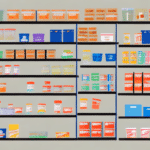Introduction to SKU Rationalization
SKU Rationalization is a strategic process that enables businesses to streamline their operations by optimizing product offerings. By reducing the number of Stock Keeping Units (SKUs), companies can focus on their most profitable and popular products, thereby enhancing inventory management and supply chain efficiency. This practice not only helps in minimizing waste but also in reallocating resources to more lucrative areas of the business.
Importance and Benefits of SKU Rationalization
Optimizing Inventory Management
Reducing the number of SKUs allows businesses to maintain a more manageable inventory, which leads to lower holding costs and reduced risk of overstocking or stockouts. According to a McKinsey report, companies can improve their inventory turnover by up to 25% through effective SKU rationalization.
Enhancing Supply Chain Efficiency
Focusing on fewer SKUs simplifies the supply chain, making it more responsive and flexible. This can lead to faster replenishment cycles, reduced lead times, and improved relationships with suppliers. Enhanced efficiency in the supply chain directly contributes to increased profitability and customer satisfaction.
Increasing Profitability
By concentrating on the most profitable products, businesses can maximize their revenue streams. SKU rationalization helps in eliminating low-performing products, thereby increasing overall profitability. This strategic focus ensures that resources are allocated to products that drive the highest returns.
Differences Between SKU and Product Rationalization
SKU Rationalization
SKU Rationalization involves managing individual product variations at the granular level. This includes decisions about specific sizes, colors, flavors, or other variants of a product. The goal is to identify and discontinue SKUs that do not contribute significantly to overall sales and profitability.
Product Rationalization
Product Rationalization, on the other hand, focuses on entire product lines or categories. It involves evaluating the performance of entire groups of products to determine which lines should be continued or discontinued based on their collective profitability and market demand.
Strategic Implications
While both practices aim to optimize product offerings, SKU Rationalization is more granular and ongoing, whereas Product Rationalization is broader and may occur less frequently. Combining both strategies can lead to a more comprehensive optimization of a company's product portfolio.
Challenges and Solutions in SKU Rationalization
Identifying Low-Performing SKUs
One of the primary challenges is accurately identifying which SKUs are underperforming. This requires robust data analysis to assess sales trends, profitability, and market demand. Utilizing advanced analytics tools can help in making informed decisions based on real-time data.
Managing Inventory Levels
Maintaining optimal inventory levels while discontinuing certain SKUs can be complex. Implementing demand forecasting and inventory management software can aid in balancing inventory levels to meet customer demand without overstocking.
Communicating Changes to Stakeholders
Changes in product offerings can affect relationships with suppliers and customers. Developing a clear communication strategy is essential to inform stakeholders about the changes and the reasons behind them. Transparent communication can help in mitigating any negative impacts and maintaining trust.
Solutions
- Adopt data-driven decision-making processes.
- Utilize inventory management and forecasting tools.
- Develop comprehensive communication plans for stakeholders.
- Engage with customers to understand their preferences and needs.
Implementing SKU Rationalization: A Step-by-Step Guide
1. Conduct a Comprehensive Product Audit
Begin by reviewing all existing SKUs to understand their performance metrics. Gather data on sales volume, profitability, inventory turnover, and market trends.
2. Analyze Sales and Profitability Data
Identify which SKUs contribute the most to revenue and profit. Use tools like Tableau or Power BI for advanced data visualization and analysis.
3. Identify Underperforming SKUs
Determine which SKUs have consistently low sales, high return rates, or low profitability. Consider factors such as seasonal demand and market saturation.
4. Develop a Rationalization Plan
Create a strategy for discontinuing underperforming SKUs. This may involve planning for inventory liquidation, rebranding, or repurposing products.
5. Communicate with Suppliers and Retailers
Inform your suppliers and retail partners about the changes to ensure a smooth transition. Negotiate terms for phasing out certain SKUs.
6. Monitor and Adjust
After implementation, continuously monitor the impact of SKU rationalization on inventory levels, sales, and customer satisfaction. Make adjustments as necessary to optimize the process.
The Role of Data Analysis in SKU Rationalization
Data Collection and Integration
Effective SKU Rationalization relies on accurate and comprehensive data collection. Integrate data from various sources such as sales transactions, inventory systems, and customer feedback to gain a holistic view of product performance.
Advanced Analytics Techniques
Employ advanced analytics techniques like predictive modeling and machine learning to forecast demand and identify trends. These techniques can enhance the accuracy of SKU performance predictions.
Real-Time Monitoring
Implement real-time data monitoring to track SKU performance continuously. Tools like Qlik Sense enable businesses to make data-driven decisions promptly.
Actionable Insights
Transform data into actionable insights that inform strategic decisions. For example, understanding that a particular SKU has declining sales can prompt timely discontinuation before it significantly impacts profitability.
Enhancing Inventory Management Through SKU Rationalization
Reducing Inventory Costs
By eliminating unnecessary SKUs, businesses can significantly reduce inventory holding costs. This leads to lower storage requirements and minimized capital tied up in unsold products.
Improving Forecast Accuracy
With a more focused product range, forecasting becomes more accurate. This allows for better planning and reduces the likelihood of overstocking or stockouts.
Increasing Product Turnover
SKU Rationalization facilitates higher product turnover rates by concentrating on faster-moving items. This improves cash flow and ensures that resources are allocated to products with higher demand.
Optimizing Shelf Space
Retailers can optimize shelf space by featuring top-performing SKUs, enhancing the shopping experience for customers and promoting higher sales volumes.
Case Studies: Successful SKU Rationalization in Various Industries
Retail Industry
A leading grocery retailer implemented SKU rationalization and achieved a 30% reduction in inventory costs while increasing profitability by 20%. By focusing on high-demand products, the retailer enhanced supply chain efficiency and customer satisfaction.
Fashion Industry
A global clothing manufacturer streamlined its product offerings, reducing SKUs by 25%. This led to improved inventory turnover and a 15% increase in overall sales by concentrating on best-selling items.
Consumer Electronics
A major electronics retailer optimized its product range, resulting in a 20% increase in sales and better inventory management. The focus on core products allowed for more effective marketing and sales strategies.
Home Goods Sector
A home goods retailer successfully reduced its inventory by 25% through SKU rationalization. This enabled the company to concentrate on popular products, improve profitability, and enhance customer satisfaction by ensuring product availability.
The Impact of SKU Rationalization on Customer Satisfaction and Loyalty
Improved Product Availability
By focusing on high-demand SKUs, businesses can ensure that popular products are consistently in stock. This reliability enhances customer trust and satisfaction.
Enhanced Shopping Experience
A more streamlined product range makes it easier for customers to find what they need, reducing decision fatigue and improving the overall shopping experience.
Increased Loyalty
Customers appreciate businesses that prioritize quality and availability of products. This can lead to increased loyalty and repeat business.
Sustainability and Waste Reduction
Reducing excess inventory contributes to sustainability efforts by minimizing waste. Environmentally conscious customers are more likely to support businesses that demonstrate responsible practices.
Maintaining Effective SKU Rationalization Practices Over Time
Regular Product Reviews
Conduct periodic reviews of your product offerings to ensure they remain aligned with market trends and customer preferences. This helps in identifying new opportunities for rationalization.
Continuous Data Monitoring
Implement ongoing data monitoring to track SKU performance. Utilize dashboards and reporting tools to stay informed about sales trends and inventory levels.
Adapting to Market Changes
Be agile in responding to changes in the market, such as shifts in consumer behavior or emerging competition. Adjust your SKU rationalization strategy accordingly to maintain competitiveness.
Engaging with Stakeholders
Maintain open communication with suppliers, retailers, and customers to gather feedback and insights. This collaborative approach ensures that SKU rationalization decisions are well-informed and supported by all parties.
The Future of SKU Rationalization in the Supply Chain Industry
Automation and AI Integration
Advancements in artificial intelligence and machine learning are set to revolutionize SKU rationalization. Automated systems can analyze vast amounts of data more efficiently, providing deeper insights and more accurate predictions.
Sustainability Focus
As businesses increasingly prioritize sustainability, SKU rationalization will play a crucial role in reducing waste and optimizing resource usage. Sustainable practices will become a core component of rationalization strategies.
Personalization and Customization
The future will see a balance between streamlining SKUs and offering personalized products. Businesses will leverage data to tailor product offerings to specific customer segments while maintaining operational efficiency.
Enhanced Collaboration Tools
Improved collaboration tools will facilitate better coordination between different departments and external partners, making the SKU rationalization process more seamless and effective.
Conclusion
SKU Rationalization is a powerful strategy for businesses aiming to enhance efficiency, reduce costs, and improve profitability. By focusing on the most valuable products, companies can optimize their inventory, streamline supply chains, and better meet customer needs. As technology and market dynamics evolve, SKU Rationalization will continue to be an essential practice for sustained business success.




















